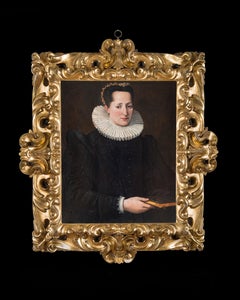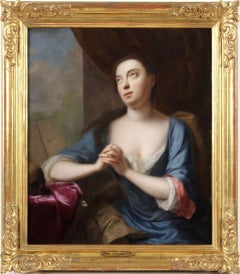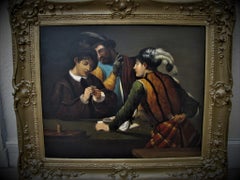16th Century Interior Paintings
to
3
1
3
3
1
2
2
Overall Height
to
Overall Width
to
1
4
3
3
1
1
1
1
1
79
354
1,813
4,954
34
38
73
99
72
135
130
147
110
111
38
4
4
3
1
1
Period: 16th Century
16th c. Flemish school - Holy family - workshop Pieter Coecke Van Aelst
Located in PARIS, FR
Holy family with an angel, workshop Pieter Coecke Van Aelst (Alost, 1502 - Bruxelles, 1550)
Faithful to the traditions of the late Gothic and early Renaissance, our painting depicts ...
Category
Old Masters 16th Century Interior Paintings
Materials
Oil, Wood Panel
Ritratto di Nobildonna
Located in Balerna, TI
Santi di Tito
Ritratto di Nobildonna
Olio su tavola, Sec. XVI, cm 74x61; con cornice 116x100x9
Con procedere degli studi su Santi di Tito, del quale è stata recentemente precisata la nascita fiorentina , si viene sempre più definendo come non solo una delle personalità più interessanti della scena artistica fiorentina, ma anche come il più interessante ritrattista cittadino della seconda metà del Cinquecento.
L'attribuzione di questo ritratto al pittore, che nell'impresa dello Studiolo di Francesco I fu uno dei maggiori innovatori fra i giovani riuniti da Vasari e Borghini, appare subito evidente per l’inconfondibile disegno ovale e fermo del volto, reso con un incarnato compatto dai toni rosati che si accende di naturalistiche notazioni epidermiche ma anche di una puntuale figurazioni degli elmenti decorativi dell’abito e dell’acconciatura. Sempre coerente con i modi pittorici di Santi è poi la pittura compatta con la quale vengono definiti i piani semplificati del volto delle donna, che conservano una notazione di luce e di naturale sensibilità in linea con i dettami controriformati dei quali il pittore fu uno dei più fedeli osservanti nella scena fiorentina. Sempre tipica di Santi di Tito è poi la ferma e volumetrica rappresentazione del torso e dell’abito definito nei piccoli intagli della stoffa ma allo stesso tempo semplificato nei volumi delle maniche e del busto. Ancora di santi ci sembra la notazione luministica con la quale è rilevato il disegno dell’abito attraverso stesure compatte ma sottili e trasparenti, oppure è resa la gorgiera bianca che aggiunge una luce netta all’intero dipinto. Una simile scelta pittorica appare nel Ritratto di Guido Guardi coi figli, esposto alla mostra Il Cinquecento a Firenze, (Palazzo Strozzi, 21 settembre 2017 – 21 gennaio 2018, n. IV. 5, pp. 156-157), dove, pur in un ritratto maschile, Santi di Tito usa la medesima cifra formale nella resa dei volti e delle gorgiere.
Pur nell'attenzione alle caratteristiche fisionomiche, Santi di Tito conserva, infatti, una cifra disegnativa sempre evidente e riconoscibile pur col passare degli anni, un carattere stilistico che sostiene, con volumi saldi, ogni sua differente prova pittorica. Ne sono un esempio dipinti quali il Ritratto di donna con Figlia, già in collezione Koelliker2, oppure il Ritratto di Lucrezia (Emilia) e Sinibaldo di Niccol Gaddi3, tutti databili agli anni settanta del Cinquecento proprio per la stereometrica definizione delle forma. Col passare degli anni, invece, tale carattere di ascendenza bronzinesca sembra cedere sempre più in favore di una pittura più morbida e sensibile, chiamata a raggiungere esiti di naturalezza sempre maggiore. Dipinto emblematico per seguire tale percorso rimane il già citato Ritratto di Guido Guardi con i figli , dove Santi di Tito ha effigiato il capofamiglia subito dopo il suo ritorno da Roma, fra il 1564 e il 1568, al tempo in cui il Guardi commission al pittore anche una pala con una Natività per la cappella di famiglia a San Giuseppe. L’uomo, seduto su uno scranno, sembra rimandare per la posa arcaizzante alla ritrattistica di primo Cinquecento, alla quale Santi di Tito s’ispira anche per le pieghe frante ma scultoree dell’abito. Sulla stessa tavola, probabilmente verso la fine degli anni settanta del Cinquecento, il pittore venne chiamato ad aggiungere le effigi di figli, quando probabilmente l’opera era già in cornice, e lo fece con una pittura più svolta e libera, in modo da raggiungere effetti naturalistici di maggiore sensibilità.
Anche nel Ritratto di donna in esame, i volumi saldi e potenti della figura spiccano sul fondo monocromo della parete con un’evidenza che farebbe pensare alle figure eseguite dalla fine degli anni Settanta del Cinquecento, al pari, appunto dei due figli di Guido Guardi.
Nato a Firenze nel 1536, Santi di Tito si form prima da Bastiano da Montecarlo per passare poi dal Bronzino, del quale conserv la preferenza per volumi luminosi e torniti, a cui aggiunse un'attenzione per la chiarezza compositiva e il naturalismo richiesti dai dettami della Controriforma, che lo portarono a guardare allo stile di Scipione Pulzone...
Category
Italian School 16th Century Interior Paintings
Materials
Oil, Panel
Ritratto di Gentiluomo con cane
Located in Balerna, TI
Bartolomeo Passerotti ( Bologna 1529 – 3 giugno 1592)
Ritratto di Gentiluomo con cane
Olio su tavola, Sec. XVI, cm 84x69; con cornice 101x87
//
Bartolomeo Passerotti (Bologna 1529...
Category
Italian School 16th Century Interior Paintings
Materials
Oil, Panel
Joseph and Potiphar's Wife
Located in New York, NY
Provenance:
Palazzo Pisani at San Stefano, Venice
Mrs. F. Craighead (possibly Mrs. Fay Stinson Craighead, Evansville, Indiana)
Sale, Sotheby Parke Bernet, New York, 7 June 1978, lot 310, as Bonifazio Veronese
Daniel M. Friedenberg, New York, until 2011; and by descent to:
Russell Friedenberg, until 2014
Literature:
Giuseppe Pavanello, Gli Inventari di Pietro Edwards nella Biblioteca del Seminario Patriarcale di Venezia, Venice 2006, pp. 132, 140, as no. 10 in Pietro Edwards’ inventory of the Palazzo Pisani: “Giuseppe che fugge dalla moglie di Pitifarre” by Bonifacio Veronese.
Philip Cottrell and Peter Humfrey, Bonifacio de’ Pitati, (forthcoming), cat. no. 166h.
Antonio Palma is the least well-known member of the illustrious Palma family of Venetian painters of the 16th century. He was the nephew of Jacopo Palma—Palma il Vecchio—and upon his uncle’s death in 1528, he began to work with Palma Vecchio’s principal student and the inheritor of the elder artist’s studio, Bonifazio de’ Pitati (Bonifazio Veronese). Antonio worked with Bonifazio as his principal assistant and right-hand man until Bonifazio’s death in 1553, after which he continued his independent career. He married a niece of his master, and their second son, Jacopo, born in 1648, would achieve fame as Palma il Giovane...
Category
Renaissance 16th Century Interior Paintings
Materials
Oil, Canvas
Related Items
Mary Magdalene - Faith transforms inner into outer beauty and conquers death -
Located in Berlin, DE
Balthasar Denner (1685 Hamburg - 1749 Rostock). Mary Magdalene. Oil on copper, 37 × 32 cm (visible size), 45 x 40 cm (frame), signed and indistinctly dated "Denner 17(...)" at centre...
Category
Old Masters 16th Century Interior Paintings
Materials
Copper
Free Shipping
H 14.57 in W 12.6 in
19th Century portrait after caravaggio "The Card Sharps"
By (After) Caravaggio
Located in York, GB
A fine painting after Caravaggio of "The card sharps" housed in a gilt frame, excellent condition.
The size overall being 99 cm x 86 cm whils...
Category
Old Masters 16th Century Interior Paintings
Materials
Oil
Free Shipping
H 33.86 in W 38.98 in D 1.97 in
Tavern Interior - 17th Century Flemish Old Master Oil on Panel Painting
Located in Sevenoaks, GB
A beautiful mid 17th century Flemish Old Master oil on panel depicting figures in a tavern interior by Anthonie Victoryns. Excellent quality early F...
Category
Old Masters 16th Century Interior Paintings
Materials
Oil, Panel
Free Shipping
H 15.36 in W 19.3 in
Adriaen van Ostade (follower of) - A Woman Dancing to the Music from a Violin
Located in Stockholm, SE
Adriaen van Ostade (follower of)
A Women Dancing to the Music from a Violin
oil on oak panel
panel size 10.23 x 15.35 inches (26 x 39 cm)
frame 15.74 x 21.25 inches (40 x 54 cm)
f...
Category
Old Masters 16th Century Interior Paintings
Materials
Panel, Oil
H 11.03 in W 15.36 in
Baroque Italian painter - Set of four 18th century figure paintings - Evangelist
Located in Varmo, IT
Italian painter (early 18th century) - Four Evangelists.
25.5 x 19 cm without frame, 29 x 22.5 cm with frame.
Ancient oil painting on panel. in wooden frames.
Condition report: In...
Category
Old Masters 16th Century Interior Paintings
Materials
Oil, Panel
Free Shipping
H 22.84 in W 17.72 in
Antique French Oil Painting Young Boy being Read to by Elderly Man 1800's
Located in Cirencester, Gloucestershire
The Lesson
French School, early 19th century
oil on canvas, unframed
canvas: 32 x 24 inches
provenance: private collection
condition: good and sound condition
Category
Old Masters 16th Century Interior Paintings
Materials
Oil, Canvas
1 bid
No Reserve
H 32 in W 24 in
"A Reverie During The Ball", 19th Century Oil on Canvas by Rogelio Egusquiza
Located in Madrid, ES
ROGELIO DE EGUSQUIZA
Spanish, 1845 - 1915
A REVERIE DURING THE BALL
signed and dated "Rogelio Egusquiza, 1879" (lower right)
oil on canvas
21-3/4 X 3...
Category
Symbolist 16th Century Interior Paintings
Materials
Canvas, Oil
Italian Vanitas painter - 19th century figure painting - Memento Mori
Located in Varmo, IT
Italian painter (19th century) - Memento Mori.
43 x 67 cm without frame, 48.5 x 72.5 cm with frame.
Antique oil painting on wood, in a wooden frame.
Condition report: Original can...
Category
Old Masters 16th Century Interior Paintings
Materials
Oil, Panel
Free Shipping
H 19.1 in W 28.55 in
Dutch 17th Century Oil Painting - The Card Game by Ter Borch
By Gerard ter Borch the Younger
Located in London, GB
Gerard ter Borch
The Cards Game
Oil on canvas
14 x 15.5 inches unframed
19 3/4 x 21 1/2 inches framed
Gerard ter Borch (Dutch; December 1617 – 8 December 1681), also known as Gerard Terburg, was an influential and pioneering Dutch genre painter who lived in the Dutch Golden Age. He influenced fellow Dutch painters Gabriel Metsu...
Category
Old Masters 16th Century Interior Paintings
Materials
Oil
Scholar Sharpening His Quill Penn Attributed to Justus Juncker, Oil on Panel
Located in Stockholm, SE
Justus Juncker (1703-1763, Germany) Attributed to
Scholar Sharpening His Quill Penn
Expertise: We would like to thank Dr. Fred G Meijer for his valuab...
Category
Old Masters 16th Century Interior Paintings
Materials
Oil, Oak, Panel
Free Shipping
H 11.82 in W 9.45 in
Grandpa and Naughty Boy Danish Master Genre Scene 19th century Signed Framed
By Erik Ludwig Henningsen
Located in Stockholm, SE
Signed lower right “Henningsen” and dated 1881 at reverse. Attributed by Erik Ludvig Henningsen (1855 - 1930) was a Danish painter and illustrator. Masterly painted genre scene “testing grandfather’s pipe” depicting lively domestic moment. The little prankster wants to be like his grandfather, but how can he not try his grandfather’s pipe, which he loves so much and does not let go of even in his sleep. The curious and brave sly man, despite the consequences, took off his shoes to approach quietly... One can imagine his disappointment and emotions after he accomplished what he had planned... The boy's faithful friend, a small dog, looks at all this with interest and curiosity. Loved and admired for his talent to realistically portray life and tell a story at the same time, Henningsen took great pride to never include any personal feelings or philosophy, but to stay neutral to the subject matter for whichever painting he was doing. Antique oil painting on canvas, signed, framed.
Size: 43 cm x 35 cm (roughly 16.9 x 13.8 in), frame 52 x 43.5 cm (roughly 20.5 x 17.1 in). Very Good pristine condition with minimal wear. Please study good resolution images for cosmetic condition. In person actual painting may appear darker or brighter than in our pictures, strictly depending on sufficient light in your environment. Weight of app. 1 kg is going to measure some 2 kg packed for shipment.
Erik Henningsen was educated at the Copenhagen Royal Academy of Art. He Traveled and studied in Germany, Italy, France and Holland, and received numerous awards and medals throughout Europe. He later became a member of the Royal Academy of Art. Exhibited in Charlottenborg, Copenhagen, Vienna, Paris, Berlin, Munich, Lubeck, and many more. Erik Henningsen is always mentioned in the same breath as his older brother, painter Frants Henningsen. Both with their traditionally classic approach to realism, anecdotal undertones and bold use of dark colors, they were the most loved and celebrated illustrators of life and times; often depicting the hardships and trials of that day and age. One of Erik Henningsen’s large...
Category
Realist 16th Century Interior Paintings
Materials
Canvas, Wood, Oil
Fine Classical Still Life Flower Painting Signed & Dated English Oil
Located in Cirencester, Gloucestershire
Classical Still Life of Flowers
English artist, 20th century
signed oil on board, unframed
dated 1980
board: 14.5 x 11.5 inches
provenance: private collection, UK
condition: overall ...
Category
Old Masters 16th Century Interior Paintings
Materials
Oil
Previously Available Items
Abstract 22147
Located in Sempach, LU
ARTIST - Alex Senchenko ©
Title : Abstract 22147
Technique: Acrylic & structure on canvas
50cm. x 100cm.
4 cm. Deep Professional Gallery Stretched Canvas, Acrylic Paints
"GALL...
Category
Abstract 16th Century Interior Paintings
Materials
Acrylic
16-17th century Venetian - Cretan figure painting - Christ cross - Oil on panel
Located in Varmo, IT
Venetian-Cretan painter of the 16th-17th century. - Deposition with the Virgin and Saints.
54.5 x 45.5 cm without frame, 72 x 62 cm with frame.
O...
Category
Mannerist 16th Century Interior Paintings
Materials
Oil, Panel
Free Shipping
H 28.35 in W 24.41 in
16th century Italian figure painting - St. Catherine - Oil on panel Renaissance
Located in Varmo, IT
Italian master of the 16th century - "St. Catherine of Alexandria".
Oil on panel, without frame.
Category
Old Masters 16th Century Interior Paintings
Materials
Oil, Wood Panel
Free Shipping
H 25.2 in W 17.52 in
Scenes from the Life of St. John the Baptist
By Girolamo Comi
Located in New York, NY
Medium: Oil on panel, with sgrafitto gilding
Signed across the ledge at bottom: GIROLAMO COMA PINGEBAT 1563
This unusual painting –unusual in both technique and subject—is a rare ex...
Category
Renaissance 16th Century Interior Paintings
Materials
Gold Leaf







